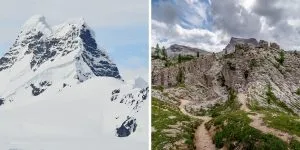Typically, when you think of a desert, you’ll conjure up images of sand dunes and cacti which leads many people to assume that the Antarctic is a tundra, whereas others argue that it’s a cold desert. So which is it – a desert or a tundra?
Both! Antarctica is a desert because it receives less than 250mm of rain or snow per year which is the agreed criteria. Parts of the Antarctic peninsular and nearby islands such as South Shetland, South Georgia and the Falkland Islands are tundra because summer temperatures exceed 0°C (32°F).
Keep reading to find out more about the different classifications and how the climate of Antarctica fits into these.
Is Antarctica a Desert?
The main identifying factors of a desert are the low levels of precipitation (i.e. rain, snow, and fog) and few plants. The general agreement among scientists is that a desert receives less than 250mm (10″) of precipitation per year1 (source: Essentials of Geology, 3rd ed, Marshak, 2009), although some such as Atacama Desert in South America receive as little as 15mm per year.
Antarctica receives an average of 150mm of precipitation per year across the continent so it can be classified as a desert. This is usually in the form of snow or ice crystals, but rain is also observed in coastal areas2 (source: Australian Antarctic Program).
However, Antarctica is a vast continent that covers 14.2million km2 (bigger than Europe which covers 10.18 million km2) so there are different climates across the region.
For example, the elevated plateau over the geographic south pole, precipitation can be lower than 50mm per year whereas it can typically exceed 200mm per year near the coast3 (source: Australian Antarctic Program).
Under the Köppen climate classification, which looks at both precipitation and average temperatures, Antarctica would be considered an ice cap rather than a true desert. The criteria of an ice cap is a monthly average temperature below 0°C (32 °F) which Antarctica easily meets with average temperatures ranging from -10°C and -60°C across the continent4 (source: British Antarctic Survey).
However, the peninsular can also be considered a tundra, more on this below.
Why is Antarctica a Desert?
Antarctica was once a warm continent with conifer rainforest and temperatures around 12°C – 13°C (53°F – 55°F), but this was around 100m years ago5 (source: The Guardian), so how did it become a polar desert?
then, around 34 million years ago, a cooling of Earth’s climate allowed the continent to freeze over. Most of the evidence suggests that a large amount of CO2 is in the atmosphere caused this to happen6 (source: Carbon Brief).
Antarctic Desert Facts
Here are a few interesting facts about the Antarctic desert:
- Antarctica was once part of a supercontinent with India and Africa called Gondwana. Back then, the Earth was warmer and Antarctica was full of plants and animals7 (source: Live Science).
- Antarctica is home to Lambert Glacier which holds the world record for the world’s longest glacier8 (source: Guinness World Records), however, this was once a flat area drained by slow rivers until the glaciers formed and carved deep valleys.
- The Antarctic Peninsula is one of the most rapidly warming parts of the planet
- It’s estimated that the total potential contribution to rising sea levels from Antarctica is 58m9 (source: British Antarctic Survey)
What are the Largest Deserts on Earth?
Antarctica is the largest desert in the world at 14.2million km2 (5.5million sqm), this is closely followed by the Arctic which is also a desert.
Here are the top 10 deserts in the world by area according to the CIA Factbook.
| Desert | Area |
|---|---|
| Antartica | 14,200,000 sq km |
| Arctic | 13,900,000 sq km |
| Sahara | 9,200,000 sq km |
| Arabian | 2,330,000 sq km |
| Gobi | 1,295,000 sq km; |
| Kalahari | 900,000 sq km |
| Patagonian | 673,000 sq km |
| Syrian | 500,000 sq km |
| Chihuahuan | 362,000 sq km |
| Kara-Kum | 350,000 sq km |
Is Antarctica a Tundra?
Under the Köppen climate system, there are two types of polar climate; ice cap and tundra.
These are classified as follows:
- Ice cap: Monthly average temperatures never exceed 0°C (32°F)
- Tundra: Warmest month has an average temperature between 0-10°C (32-50°F)
Most of Antarctica has monthly average temperatures below 0°C year-round and therefore it’s an ice cap.
However, the Antarctic Peninsula (the northernmost part of the continent south of Argentina) has a much higher average monthly temperature that often exceeds 0°C (32°F) in the summer months10 (source: British Antarctic Survey) and therefore this area can be classified as a tundra rather than an ice cap.
The main difference between an ice cap and tundra is that snow will melt from a tundra during summer which allows vegetation to grow whereas an ice cap will remain snow-covered as the temperatures stay below freezing.
Many surrounding regions are also considered tundra including the Scotia Sea (made up of South Georgia and the South Sandwich Islands, South Shetland Islands, and Bouvet Island) and the Falkland Islands.
Is Antarctica Made of Ice or Land?
Unlike the north pole which is ice floating on the Arctic Ocean, Antarctica has a landmass underneath.
Underneath the permanent 1-2 mile thick snow lies rocky terrain with mountain ranges, gorges, and valleys. The average bed depth of Antarctica is 95m above sea level, however, the deepest point under Byrd Glacier is 2,870m below sea level11 (source: British Antarctic Survey).
Before Antarctica became permanently snow-covered over 34 million years ago, there was once a large river that ran across the continent12 (source: Live Science).
This YouTube video compiled by the British Antarctic Survey in partnership with NASA shows what the continent would look like if all the snow was removed. As you can see, the snow-covered landmass is also surrounded by seasonal sea ice.
Related Questions
What Happens to the Size of Antarctica During Winter?
Antarctica is a large snow-covered landmass that is surrounded by vast amounts of sea ice in the winter. During the summer, most of this sea ice melts which gives the impression that Antarctica is smaller in summer than it is in winter.
Is Antarctica a Continent?
Yes, Antarctica is a continent that sits on the Antarctic tectonic plate. It is considered to be a continent because underneath the snow and ice is a large landmass that’s surrounded by ocean.
It also has very distinct characteristics com[pared to other continents, including its geology (terrain, plants, and animals), and anthropology (people and cultures).
Find out more about why Antarctica is a continent.


![You are currently viewing Is Antarctica a Desert or Tundra? [Both – Here’s How]](https://polarguidebook.com/wp-content/uploads/2021/07/Antarctic-Desert.jpg)

![Read more about the article How to Get a Job in Antarctica in 2024 [According to People Working There]](https://polarguidebook.com/wp-content/uploads/2023/08/Untitled-design-23-300x176.png)
